Exploration of Differences in Housing Price Determinants Based on Street View Imagery and the Geographical-XGBoost Model: Improving Quality of Life for Residents and Through-Travelers
Abstract
1. Introduction
2. Study Area and Data
2.1. Study Area
2.2. Research Framework
2.3. Data
2.4. Street View Feature Extraction
3. Methodology
3.1. Housing Price Models
3.2. Geographical-XGBoost
3.3. Subjective Perception Modeling
4. Results
4.1. Modeling and Spatial Analysis of Street Perceptions
4.2. Spatial Hedonic Model Results
4.3. Spatial Heterogeneity and Nonlinear Effects in Housing Price Drivers
5. Discussion
5.1. The Impact of Street Design Quality on Property Prices
5.2. The Intertwined Effects of Factors Influencing Housing Prices
5.3. Implications for Urban Planning
5.4. Limitations and Potential Improvements
6. Conclusions
Author Contributions
Funding
Data Availability Statement
Conflicts of Interest
Appendix A
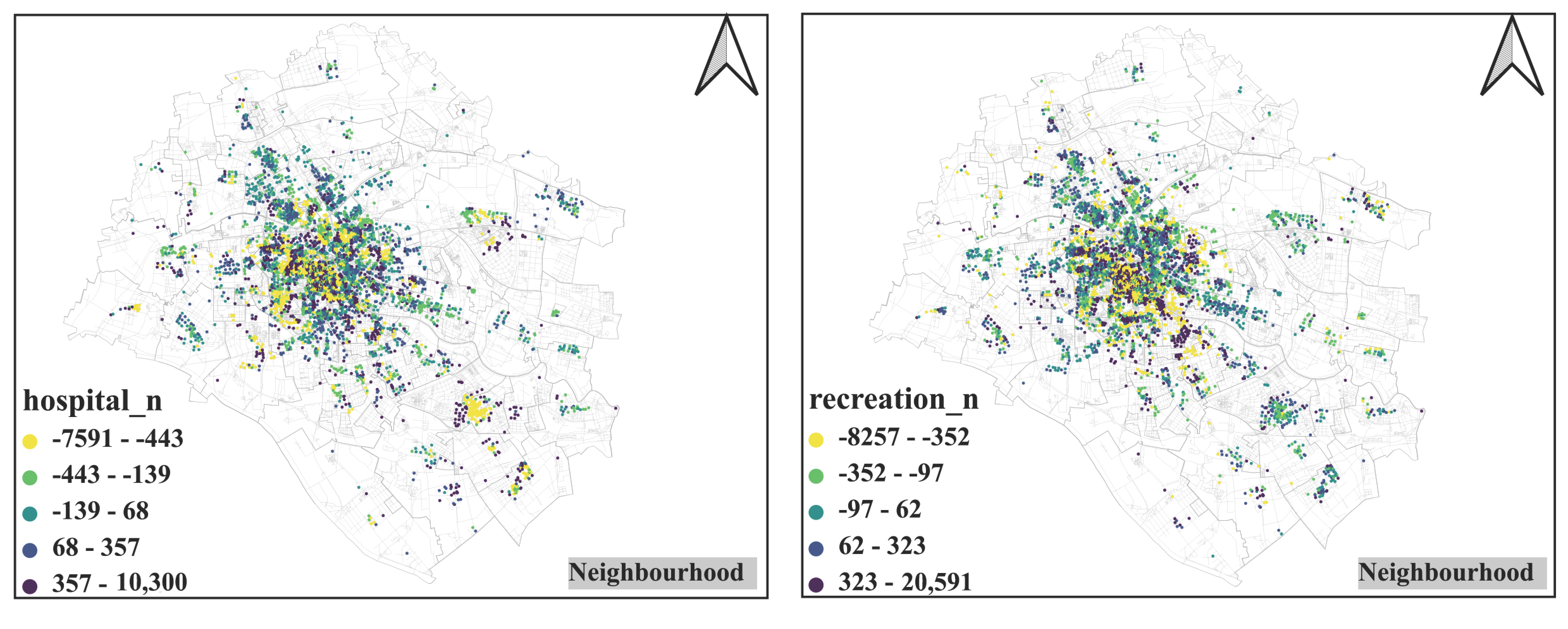
References
- WHO. Air Pollution and Child Health: Prescribing Clean Air; World Health Organization: Geneva, Switzerland, 2018. [Google Scholar]
- Liu, R.; Li, T.; Greene, R. Migration and Inequality in Rental Housing: Affordability Stress in the Chinese Cities. Appl. Geogr. 2020, 115, 102138. [Google Scholar] [CrossRef]
- Geng, B.; Bao, H.; Liang, Y. A Study of the Effect of a High-Speed Rail Station on Spatial Variations in Housing Price Based on the Hedonic Model. Habitat Int. 2015, 49, 333–339. [Google Scholar] [CrossRef]
- Li, Y.; Lin, Y.; Wang, J.; Geertman, S.; Hooimeijer, P. The effects of jobs, amenities, and locations on housing submarkets in Xiamen City, China. J. Hous. Built Environ. 2023, 38, 1221–1239. [Google Scholar] [CrossRef]
- Köberl, M.; Wurm, M.; Droin, A.; Garbasevschi, O.M.; Dolls, M.; Taubenböck, H. Liveability in Large Housing Estates in Germany—Identifying Differences Based on a Novel Concept for a Walkable City. Landsc. Urban Plan. 2024, 251, 105150. [Google Scholar] [CrossRef]
- Xu, Y.; Chen, R.; Du, H.; Chen, M.; Fu, C.; Li, Y. Evaluation of green space influence on housing prices using machine learning and urban visual intelligence. Cities 2025, 158, 105661. [Google Scholar] [CrossRef]
- Xu, Y.; Wang, L. GIS-based analysis of obesity and the built environment in the US. Cartogr. Geogr. Inf. Sci. 2015, 42, 9–21. [Google Scholar] [CrossRef]
- Zhu, J.; Gong, Y.; Liu, C.; Du, J.; Song, C.; Chen, J.; Pei, T. Assessing the Effects of Subjective and Objective Measures on Housing Prices with Street View Imagery: A Case Study of Suzhou. Land 2023, 12, 2095. [Google Scholar] [CrossRef]
- Liu, N.; Strobl, J. Impact of Neighborhood Features on Housing Resale Prices in Zhuhai (China) Based on an (M)GWR Model. Big Earth Data 2023, 7, 146–169. [Google Scholar] [CrossRef]
- Wen, H.; Tao, Y. Polycentric Urban Structure and Housing Price in the Transitional China: Evidence from Hangzhou. Habitat Int. 2015, 46, 138–146. [Google Scholar] [CrossRef]
- Chen, J.; Hao, Q. The Impacts of Distance to CBD on Housing Prices in Shanghai: A Hedonic Analysis. J. Chin. Econ. Bus. Stud. 2008, 6, 291–302. [Google Scholar] [CrossRef]
- Liang, X.; Liu, Y.; Qiu, T.; Jing, Y.; Fang, F. The Effects of Locational Factors on the Housing Prices of Residential Communities: The Case of Ningbo, China. Habitat Int. 2018, 81, 1–11. [Google Scholar] [CrossRef]
- Wen, H.; Zhang, Y.; Zhang, L. Do Educational Facilities Affect Housing Price? An Empirical Study in Hangzhou, China. Habitat Int. 2014, 42, 155–163. [Google Scholar] [CrossRef]
- Qiu, W.; Li, W.; Liu, X.; Zhang, Z.; Li, X.; Huang, X. Subjective and Objective Measures of Streetscape Perceptions: Relationships with Property Value in Shanghai. Cities 2023, 132, 104037. [Google Scholar] [CrossRef]
- Xu, X.; Qiu, W.; Li, W.; Liu, X.; Zhang, Z.; Li, X.; Luo, D. Associations between Street-View Perceptions and Housing Prices: Subjective vs. Objective Measures Using Computer Vision and Machine Learning Techniques. Remote Sens. 2022, 14, 891. [Google Scholar] [CrossRef]
- Ewing, R.H.; Clemente, O.; Neckerman, K.M.; Purciel-Hill, M.; Quinn, J.W.; Rundle, A. Measuring Urban Design: Metrics for Livable Places; Island Press: Washington, DC, USA, 2013; Volume 200. [Google Scholar]
- Ma, X.; Ma, C.; Wu, C.; Xi, Y.; Yang, R.; Peng, N.; Zhang, C.; Ren, F. Measuring human perceptions of streetscapes to better inform urban renewal: A perspective of scene semantic parsing. Cities 2021, 110, 103086. [Google Scholar] [CrossRef]
- Cheng, J.; Zhang, X.; Huang, J. Optimizing the spatial scale for neighborhood environment characteristics using fine-grained data. Int. J. Appl. Earth Obs. Geoinf. 2022, 106, 102659. [Google Scholar] [CrossRef]
- Sander, H.; Polasky, S.; Haight, R.G. The value of urban tree cover: A hedonic property price model in Ramsey and Dakota Counties, Minnesota, USA. Ecol. Econ. 2010, 69, 1646–1656. [Google Scholar] [CrossRef]
- Campos Ferreira, M.; Dias Costa, P.; Abrantes, D.; Hora, J.; Felício, S.; Coimbra, M.; Galvão Dias, T. Identifying the determinants and understanding their effect on the perception of safety, security, and comfort by pedestrians and cyclists: A systematic review. Transp. Res. Part Traffic Psychol. Behav. 2022, 91, 136–163. [Google Scholar] [CrossRef]
- Hamim, O.F.; Ukkusuri, S.V. Towards safer streets: A framework for unveiling pedestrians’ perceived road safety using street view imagery. Accid. Anal. Prev. 2024, 195, 107400. [Google Scholar] [CrossRef] [PubMed]
- Li, X.; Zhang, C.; Li, W.; Ricard, R.; Meng, Q.; Zhang, W. Assessing street-level urban greenery using Google Street View and a modified green view index. Urban For. Urban Green. 2015, 14, 675–685. [Google Scholar] [CrossRef]
- Yin, L.; Wang, Z. Measuring visual enclosure for street walkability: Using machine learning algorithms and Google Street View imagery. Appl. Geogr. 2016, 76, 147–153. [Google Scholar] [CrossRef]
- Zhou, H.; He, S.; Cai, Y.; Wang, M.; Su, S. Social inequalities in neighborhood visual walkability: Using street view imagery and deep learning technologies to facilitate healthy city planning. Sustain. Cities Soc. 2019, 50, 101605. [Google Scholar] [CrossRef]
- Ewing, R.; Handy, S. Measuring the Unmeasurable: Urban Design Qualities Related to Walkability. J. Urban Des. 2009, 14, 65–84. [Google Scholar] [CrossRef]
- Qiu, W.; Zhang, Z.; Liu, X.; Li, W.; Li, X.; Xu, X.; Huang, X. Subjective or objective measures of street environment, which are more effective in explaining housing prices? Landsc. Urban Plan. 2022, 221, 104358. [Google Scholar] [CrossRef]
- Despotovic, M.; Koch, D.; Thaler, S.; Stumpe, E.; Brunauer, W.; Zeppelzauer, M. Linking repeated subjective judgments and ConvNets for multimodal assessment of the immediate living environment. MethodsX 2024, 12, 102556. [Google Scholar] [CrossRef]
- Tang, Y.; Xiao, W.; Yuan, F. Evaluating objective and perceived ecosystem service in urban context: An indirect method based on housing market. Landsc. Urban Plan. 2025, 254, 105245. [Google Scholar] [CrossRef]
- Dubey, A.; Naik, N.; Parikh, D.; Raskar, R.; Hidalgo, C.A. Deep Learning the City: Quantifying Urban Perception at a Global Scale. In Proceedings of the Computer Vision—ECCV 2016, Amsterdam, The Netherlands, 11–14 October 2016; Leibe, B., Matas, J., Sebe, N., Welling, M., Eds.; Springer: Cham, Switzerland, 2016; pp. 196–212. [Google Scholar] [CrossRef]
- Kang, Y.; Zhang, F.; Gao, S.; Peng, W.; Ratti, C. Human settlement value assessment from a place perspective: Considering human dynamics and perceptions in house price modeling. Cities 2021, 118, 103333. [Google Scholar] [CrossRef]
- Sun, M.; Zhang, F.; Duarte, F.; Ratti, C. Understanding architecture age and style through deep learning. Cities 2022, 128, 103787. [Google Scholar] [CrossRef]
- Rosen, S. Hedonic Prices and Implicit Markets: Product Differentiation in Pure Competition. J. Political Econ. 1974, 82, 34–55. [Google Scholar] [CrossRef]
- Su, S.; Zhang, J.; He, S.; Zhang, H.; Hu, L.; Kang, M. Unraveling the impact of TOD on housing rental prices and implications on spatial planning: A comparative analysis of five Chinese megacities. Habitat Int. 2021, 107, 102309. [Google Scholar] [CrossRef]
- Wu, C.; Ye, X.; Du, Q.; Luo, P. Spatial effects of accessibility to parks on housing prices in Shenzhen, China. Habitat Int. 2017, 63, 45–54. [Google Scholar] [CrossRef]
- Wan, H.; Chowdhury, P.K.R.; Yoon, J.; Bhaduri, P.; Srikrishnan, V.; Judi, D.; Daniel, B. Explaining drivers of housing prices with nonlinear hedonic regressions. Mach. Learn. Appl. 2025, 21, 100707. [Google Scholar] [CrossRef]
- McCord, M.; McCord, J.; Lo, D.; Brown, L.; MacIntyre, S.; Squires, G. The value of green and blue space: Walkability and house prices. Cities 2024, 154, 105377. [Google Scholar] [CrossRef]
- Ye, Y.; Xie, H.; Fang, J.; Jiang, H.; Wang, D. Daily Accessed Street Greenery and Housing Price: Measuring Economic Performance of Human-Scale Streetscapes via New Urban Data. Sustainability 2019, 11, 1741. [Google Scholar] [CrossRef]
- Chen, L.; Yao, X.; Liu, Y.; Zhu, Y.; Chen, W.; Zhao, X.; Chi, T. Measuring Impacts of Urban Environmental Elements on Housing Prices Based on Multisource Data—A Case Study of Shanghai, China. ISPRS Int. J.-Geo-Inf. 2020, 9, 106. [Google Scholar] [CrossRef]
- Tang, C.K.; Le, T. Crime risk and housing values: Evidence from the gun offender registry. J. Urban Econ. 2023, 134, 103526. [Google Scholar] [CrossRef]
- Shen, Y.; Karacsonyi, D. Assessing the urban–rural fringe using gradient and patch metrics in Tianjin, China. J. Geogr. Syst. 2022, 24, 77–98. [Google Scholar] [CrossRef]
- Gao, C.; Feng, Y.; Tong, X.; Lei, Z.; Chen, S.; Zhai, S. Modeling urban growth using spatially heterogeneous cellular automata models: Comparison of spatial lag, spatial error and GWR. Comput. Environ. Urban Syst. 2020, 81, 101459. [Google Scholar] [CrossRef]
- Gao, Y.; Zhao, J.; Han, L. Exploring the spatial heterogeneity of urban heat island effect and its relationship to block morphology with the geographically weighted regression model. Sustain. Cities Soc. 2022, 76, 103431. [Google Scholar] [CrossRef]
- Xie, Y.; Nhu, A.N.; Song, X.P.; Jia, X.; Skakun, S.; Li, H.; Wang, Z. Accounting for spatial variability with geo-aware random forest: A case study for US major crop mapping. Remote Sens. Environ. 2025, 319, 114585. [Google Scholar] [CrossRef]
- Ye, M.; Zhu, L.; Li, X.; Ke, Y.; Huang, Y.; Chen, B.; Yu, H.; Li, H.; Feng, H. Estimation of the soil arsenic concentration using a geographically weighted XGBoost model based on hyperspectral data. Sci. Total Environ. 2023, 858, 159798. [Google Scholar] [CrossRef] [PubMed]
- Ouyang, L.; Yang, Y.; Wu, Z.; Jiang, Q.; Qiao, R. Towards inclusive urbanism: An examination of urban environment strategies for enhancing social equity in Chengdu’s housing zones. Sustain. Cities Soc. 2024, 107, 105414. [Google Scholar] [CrossRef]
- Ge, J. Endogenous rise and collapse of housing price: An agent-based model of the housing market. Comput. Environ. Urban Syst. 2017, 62, 182–198. [Google Scholar] [CrossRef]
- Park, H.; Lee, S.; Lee, J.; Ham, B. Learning by Aligning: Visible-Infrared Person Re-identification using Cross-Modal Correspondences. In Proceedings of the 2021 IEEE/CVF International Conference on Computer Vision (ICCV), Montreal, QC, Canada, 11–17 October 2021; pp. 12026–12035. [Google Scholar] [CrossRef]
- Gibril, M.B.A.; Al-Ruzouq, R.; Shanableh, A.; Jena, R.; Bolcek, J.; Shafri, H.Z.M.; Ghorbanzadeh, O. Transformer-based semantic segmentation for large-scale building footprint extraction from very-high resolution satellite images. Adv. Space Res. 2024, 73, 4937–4954. [Google Scholar] [CrossRef]
- Gu, Y.; Fu, C.; Song, W.; Wang, X.; Chen, J. RTLinearFormer: Semantic segmentation with lightweight linear attentions. Neurocomputing 2025, 625, 129489. [Google Scholar] [CrossRef]
- Zhou, B.; Zhao, H.; Puig, X.; Fidler, S.; Barriuso, A.; Torralba, A. Scene Parsing Through ADE20K Dataset. In Proceedings of the IEEE Conference on Computer Vision and Pattern Recognition (CVPR), Honolulu, HI, USA, 21–26 July 2017. [Google Scholar]
- Gehl, J. Cities for People; Island Press: Washington, DC, USA, 2010. [Google Scholar]
- Naik, N.; Philipoom, J.; Raskar, R.; Hidalgo, C. Streetscore—Predicting the Perceived Safety of One Million Streetscapes. In Proceedings of the 2014 IEEE Conference on Computer Vision and Pattern Recognition Workshops, Columbus, OH, USA, 23–28 July 2014; pp. 793–799. [Google Scholar] [CrossRef]
- He, L.; Páez, A.; Liu, D. Built environment and violent crime: An environmental audit approach using Google Street View. Comput. Environ. Urban Syst. 2017, 66, 83–95. [Google Scholar] [CrossRef]
- Salesses, P.; Schechtner, K.; Hidalgo, C.A. The Collaborative Image of The City: Mapping the Inequality of Urban Perception. PLoS ONE 2013, 8, e68400. [Google Scholar] [CrossRef]
- Verma, D.; Jana, A.; Ramamritham, K. Predicting human perception of the urban environment in a spatiotemporal urban setting using locally acquired street view images and audio clips. Build. Environ. 2020, 186, 107340. [Google Scholar] [CrossRef]
- Ito, K.; Biljecki, F. Assessing bikeability with street view imagery and computer vision. Transp. Res. Part C Emerg. Technol. 2021, 132, 103371. [Google Scholar] [CrossRef]
- Huang, Z.; Chen, R.; Xu, D.; Zhou, W. Spatial and hedonic analysis of housing prices in Shanghai. Habitat Int. 2017, 67, 69–78. [Google Scholar] [CrossRef]
- Kutner, M.H.; Nachtsheim, C.J.; Neter, J. Applied Linear Regression Models, 4th ed.; McGraw-Hill/Irwin: Columbus, OH, USA, 2004. [Google Scholar]
- Grekousis, G. Geographical-XGBoost: A New Ensemble Model for Spatially Local Regression Based on Gradient-Boosted Trees. J. Geogr. Syst. 2025, 27, 169–195. [Google Scholar] [CrossRef]
- Li, Y.; Zhang, Y.; Wu, Q.; Xue, R.; Wang, X.; Si, M.; Zhang, Y. Greening the concrete jungle: Unveiling the co-mitigation of greenspace configuration on PM2.5 and land surface temperature with explanatory machine learning. Urban For. Urban Green. 2023, 88, 128086. [Google Scholar] [CrossRef]
- Beleites, C.; Neugebauer, U.; Bocklitz, T.; Krafft, C.; Popp, J. Sample Size Planning for Classification Models. Anal. Chim. Acta 2013, 760, 25–33. [Google Scholar] [CrossRef] [PubMed]
- Niu, T.; Chen, Y.; Yuan, Y. Measuring urban poverty using multi-source data and a random forest algorithm: A case study in Guangzhou. Sustain. Cities Soc. 2020, 54, 102014. [Google Scholar] [CrossRef]
- Yao, Y.; Liang, Z.; Yuan, Z.; Liu, P.; Bie, Y.; Zhang, J.; Wang, R.; Wang, J.; Guan, Q. A human-machine adversarial scoring framework for urban perception assessment using street-view images. Int. J. Geogr. Inf. Sci. 2019, 33, 2363–2384. [Google Scholar] [CrossRef]
- Roy, K.; Das, R.N.; Ambure, P.; Aher, R.B. Be aware of error measures. Further studies on validation of predictive QSAR models. Chemom. Intell. Lab. Syst. 2016, 152, 18–33. [Google Scholar] [CrossRef]
- Zhang, F.; Zhou, B.; Liu, L.; Liu, Y.; Fung, H.H.; Lin, H.; Ratti, C. Measuring human perceptions of a large-scale urban region using machine learning. Landsc. Urban Plan. 2018, 180, 148–160. [Google Scholar] [CrossRef]
- Griew, P.; Hillsdon, M.; Foster, C.; Coombes, E.; Jones, A.; Wilkinson, P. Developing and testing a street audit tool using Google Street View to measure environmental supportiveness for physical activity. Int. J. Behav. Nutr. Phys. Act. 2013, 10, 103. [Google Scholar] [CrossRef]
- Rundle, A.G.; Bader, M.D.; Richards, C.A.; Neckerman, K.M.; Teitler, J.O. Using Google Street View to Audit Neighborhood Environments. Am. J. Prev. Med. 2011, 40, 94–100. [Google Scholar] [CrossRef]
- Spirou, M.; Gospodini, A. Urban Morphology and Housing: A Global Perspective; Springer: Cham, Switzerland, 2019. [Google Scholar]
- Lin, L.; Moudon, A.V. Objective versus subjective measures of the built environment, which are most effective in capturing associations with walking? Health Place 2010, 16, 339–348. [Google Scholar] [CrossRef]
- Zeng, Q.; Wu, H.; Zhou, L.; Gao, X.; Fei, N.; Dewancker, B.J. Unraveling nonlinear relationship of built environment on pre-sale and second-hand housing prices using multi-source big data and machine learning. Front. Archit. Res. 2025; in press. [Google Scholar] [CrossRef]
- Yu, P.; Yung, E.H.K.; Chan, E.H.W.; Zhang, S.; Wang, S.; Chen, Y. The Spatial Effect of Accessibility to Public Service Facilities on Housing Prices: Highlighting the Housing Equity. ISPRS Int. J.-Geo-Inf. 2023, 12, 228. [Google Scholar] [CrossRef]
- Russell, S.; Kweon, B.S. The Economic Effect of Parks and Community-Managed Open Spaces on Residential House Prices in Baltimore, MD. Land 2025, 14, 483. [Google Scholar] [CrossRef]
- Hamidi, S.; Bonakdar, A.; Keshavarzi, G.; Ewing, R. Do Urban Design qualities add to property values? An empirical analysis of the relationship between Urban Design qualities and property values. Cities 2020, 98, 102564. [Google Scholar] [CrossRef]
- Gan, L.; Ren, H.; Xiang, W.; Wu, K.; Cai, W. Nonlinear Influence of Public Services on Urban Housing Prices: A Case Study of China. Land 2021, 10, 1007. [Google Scholar] [CrossRef]
- Teixeira, I.P.; Rodrigues da Silva, A.N.; Schwanen, T.; Manzato, G.G.; Dörrzapf, L.; Zeile, P.; Dekoninck, L.; Botteldooren, D. Does cycling infrastructure reduce stress biomarkers in commuting cyclists? A comparison of five European cities. J. Transp. Geogr. 2020, 88, 102830. [Google Scholar] [CrossRef]
- Song, Y.; Zhang, S.; Deng, W. Nonlinear Hierarchical Effects of Housing Prices and Built Environment Based on Multiscale Life Circle—A Case Study of Chengdu. ISPRS Int. J.-Geo-Inf. 2023, 12, 371. [Google Scholar] [CrossRef]
- Liu, Z.; Ye, J.; Ren, G.; Feng, S. The Effect of School Quality on House Prices: Evidence from Shanghai, China. Land 2022, 11, 1894. [Google Scholar] [CrossRef]
- Han, X.; Shen, Y.; Zhao, B. Winning at the starting line: The primary school premium and housing prices in Beijing. China Econ. Q. Int. 2021, 1, 29–42. [Google Scholar] [CrossRef]
- Hussain, I. Housing market and school choice response to school quality information shocks. J. Urban Econ. 2023, 138, 103606. [Google Scholar] [CrossRef]
- Liu, T.; Wang, J.; Liu, L.; Peng, Z.; Wu, H. What Are the Pivotal Factors Influencing Housing Prices? A Spatiotemporal Dynamic Analysis Across Market Cycles from Upturn to Downturn in Wuhan. Land 2025, 14, 356. [Google Scholar] [CrossRef]
- Jin, T.; Cheng, L.; Liu, Z.; Cao, J.; Huang, H.; Witlox, F. Nonlinear public transit accessibility effects on housing prices: Heterogeneity across price segments. Transp. Policy 2022, 117, 48–59. [Google Scholar] [CrossRef]
- Alonso, W. Location and Land Use: Toward a General Theory of Land Rent; Publications of the Joint Center for Urban Studies of the MA, Harvard University Press: Cambridge, MA, USA, 1964. [Google Scholar]
- Chen, Y.; Tian, L.; Chen, Y. Exploring the effects of streetscape greenery on housing price: Evidence from the hedonic price model and SVF-based spatial analysis in Shenzhen, China. Landsc. Urban Plan. 2020, 195, 103706. [Google Scholar] [CrossRef]
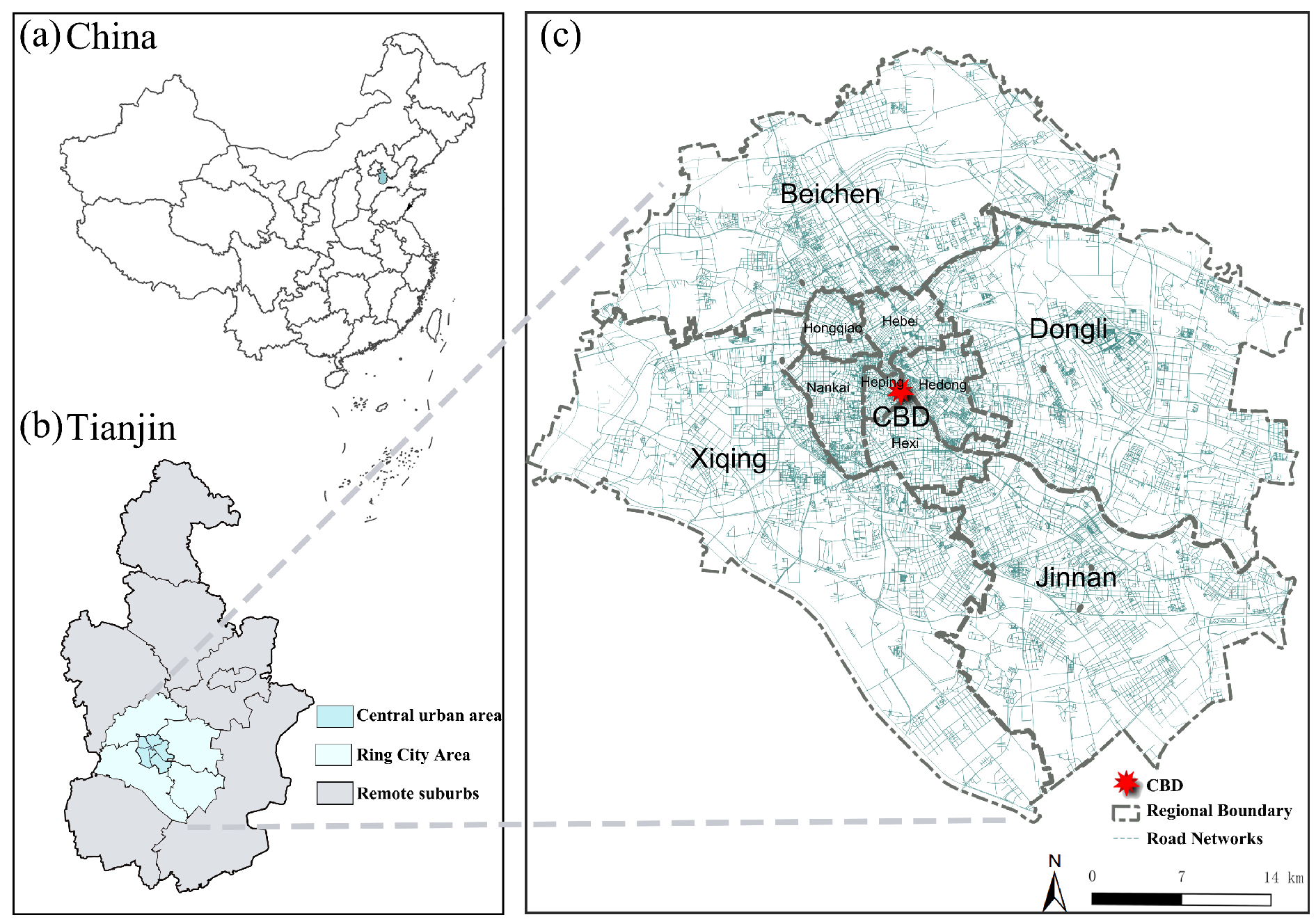
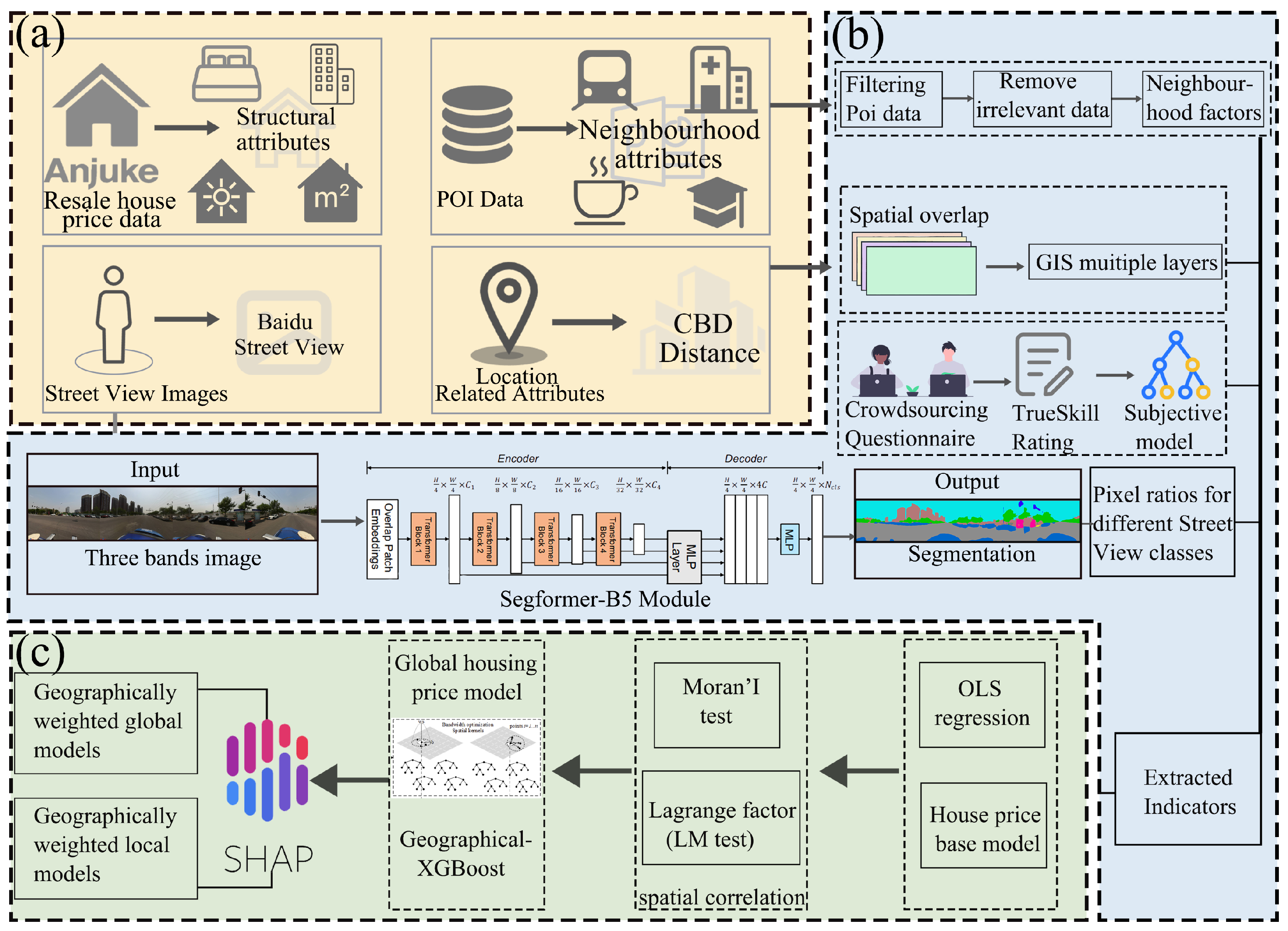
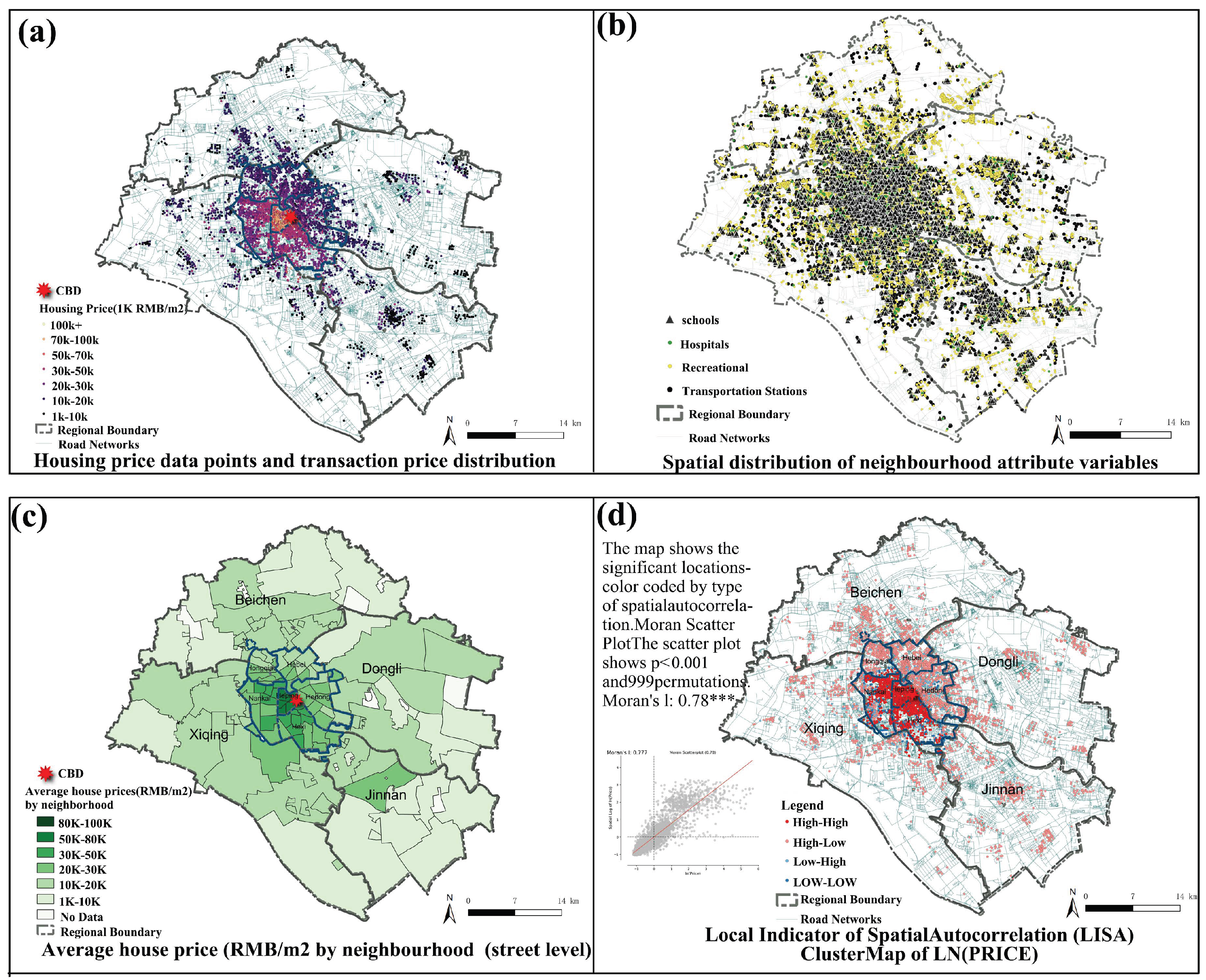
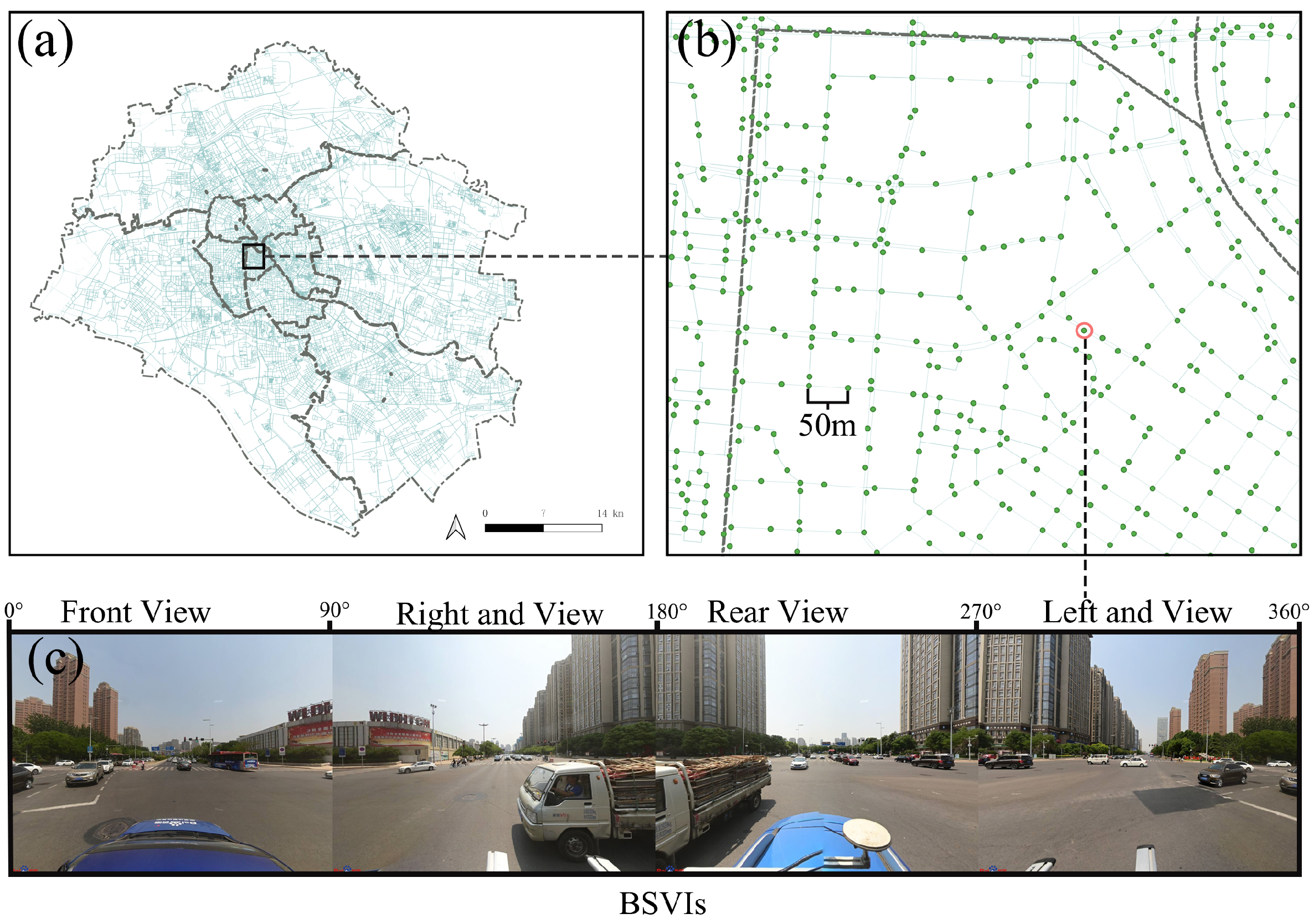
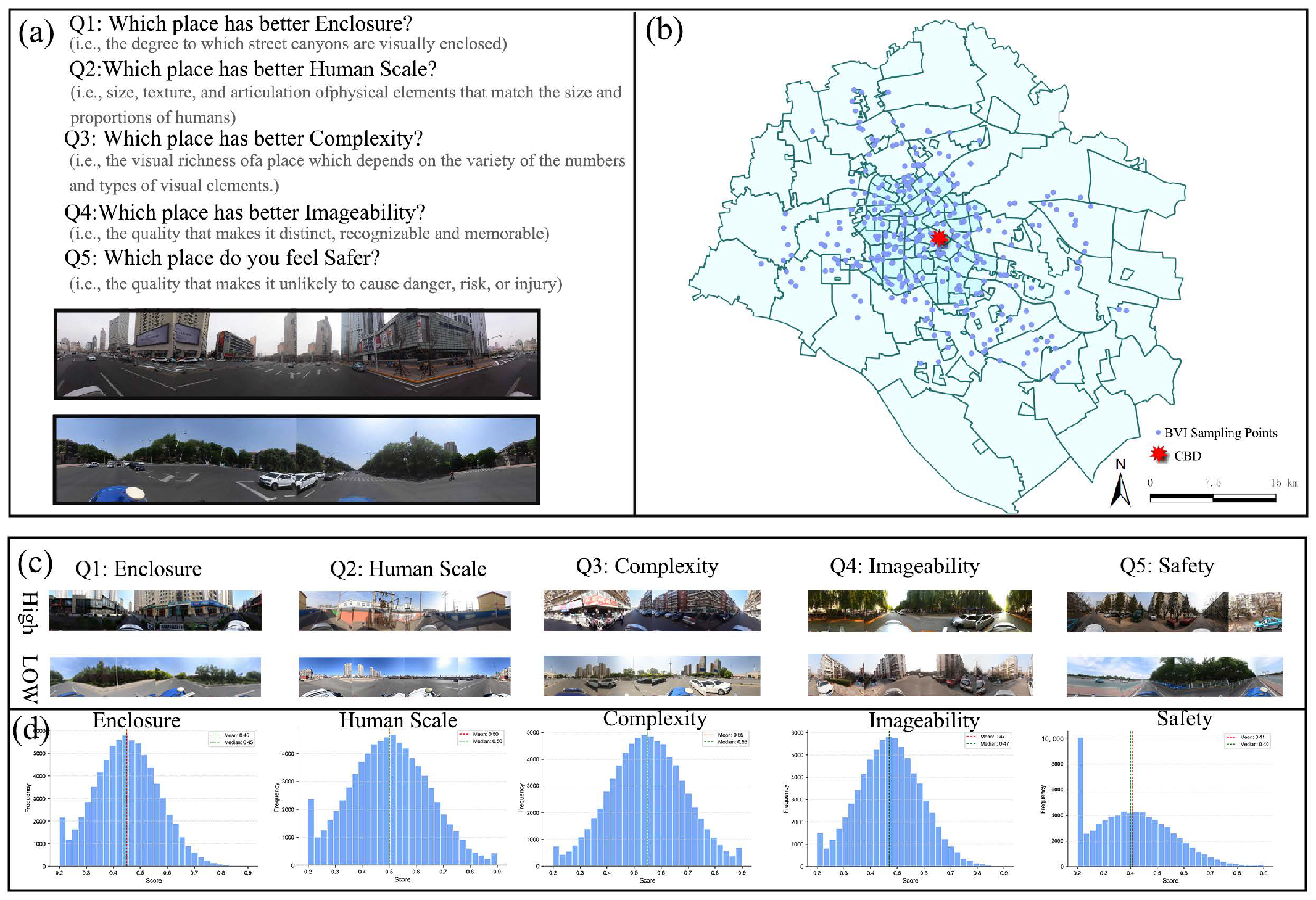
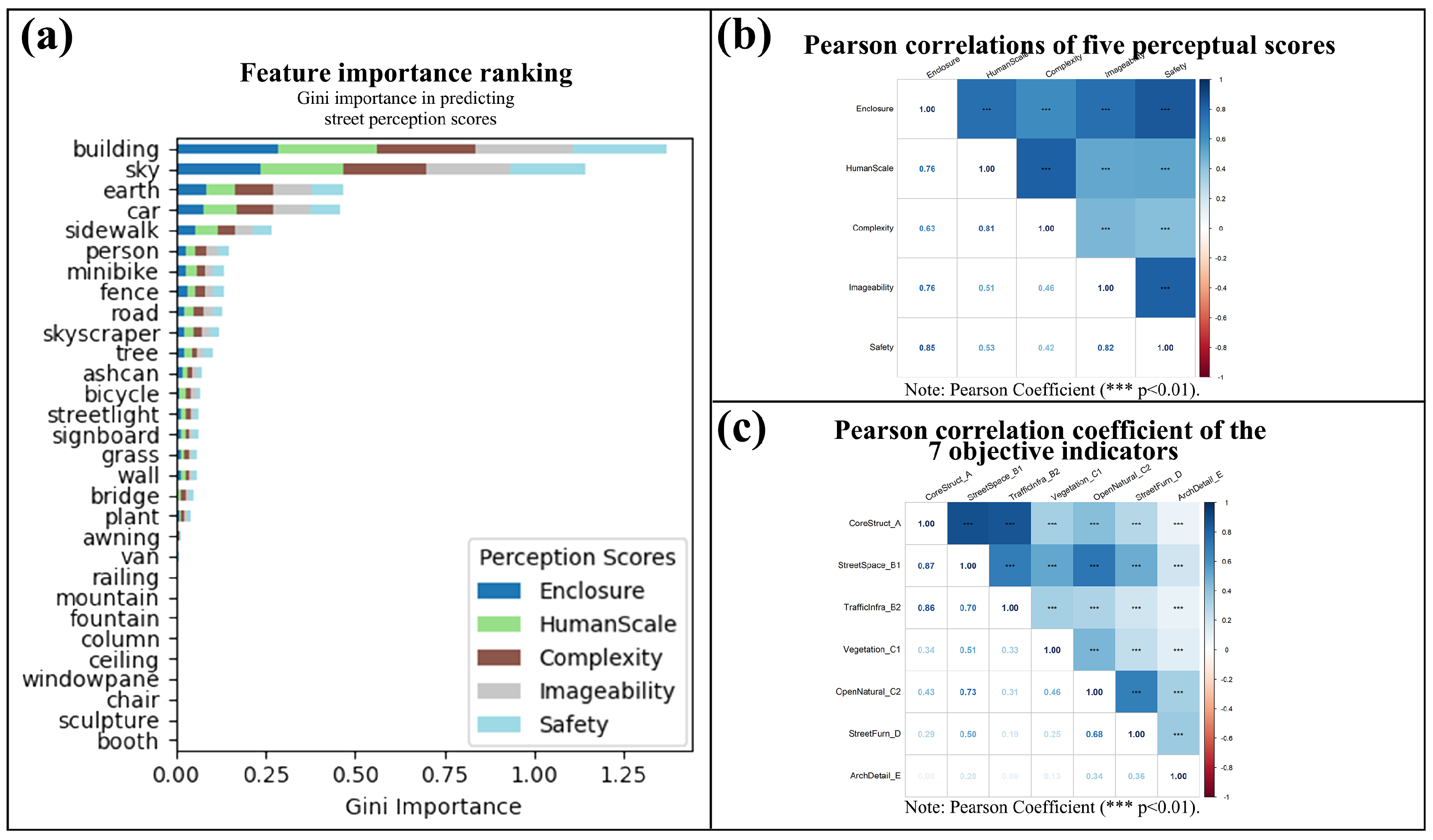
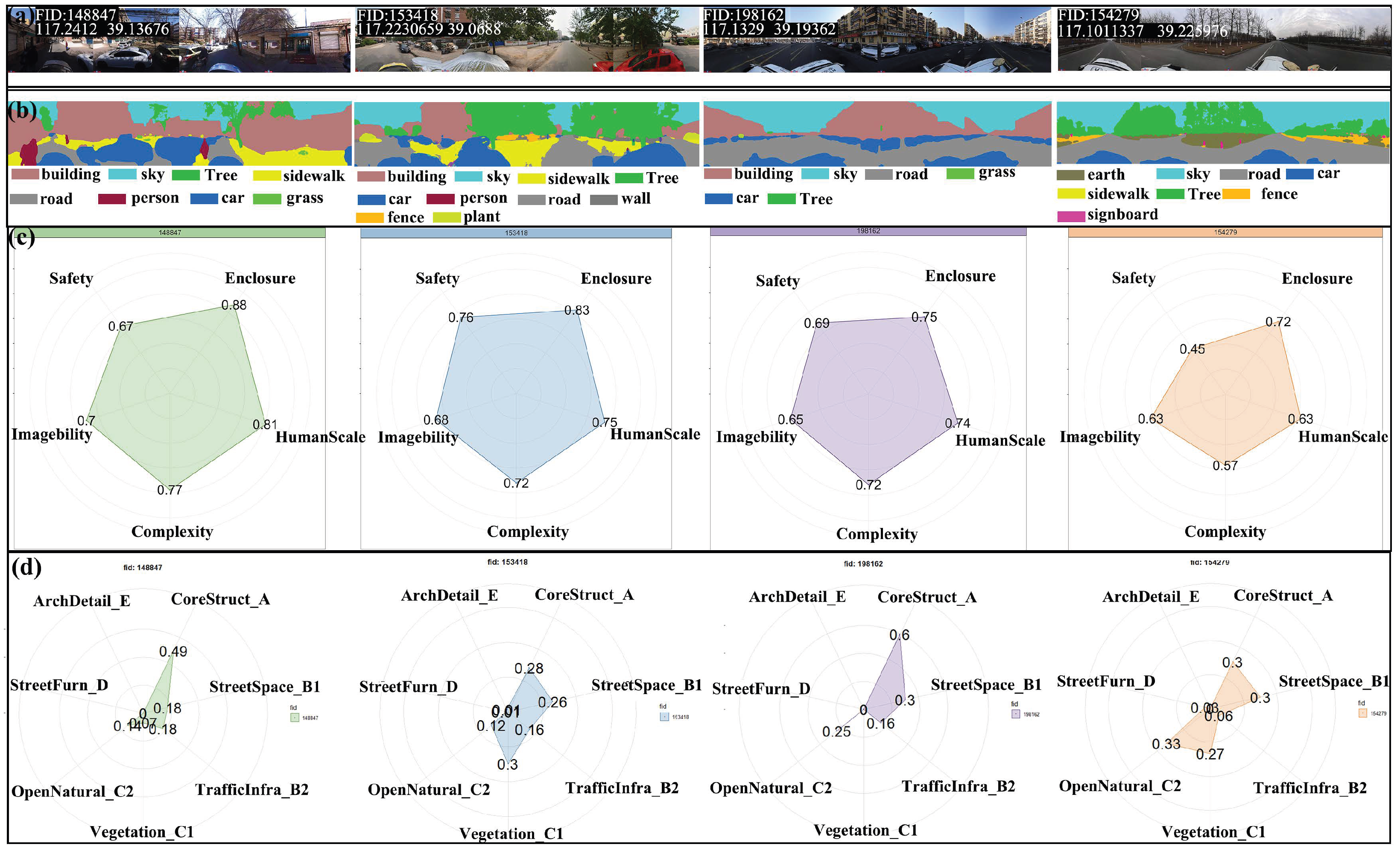
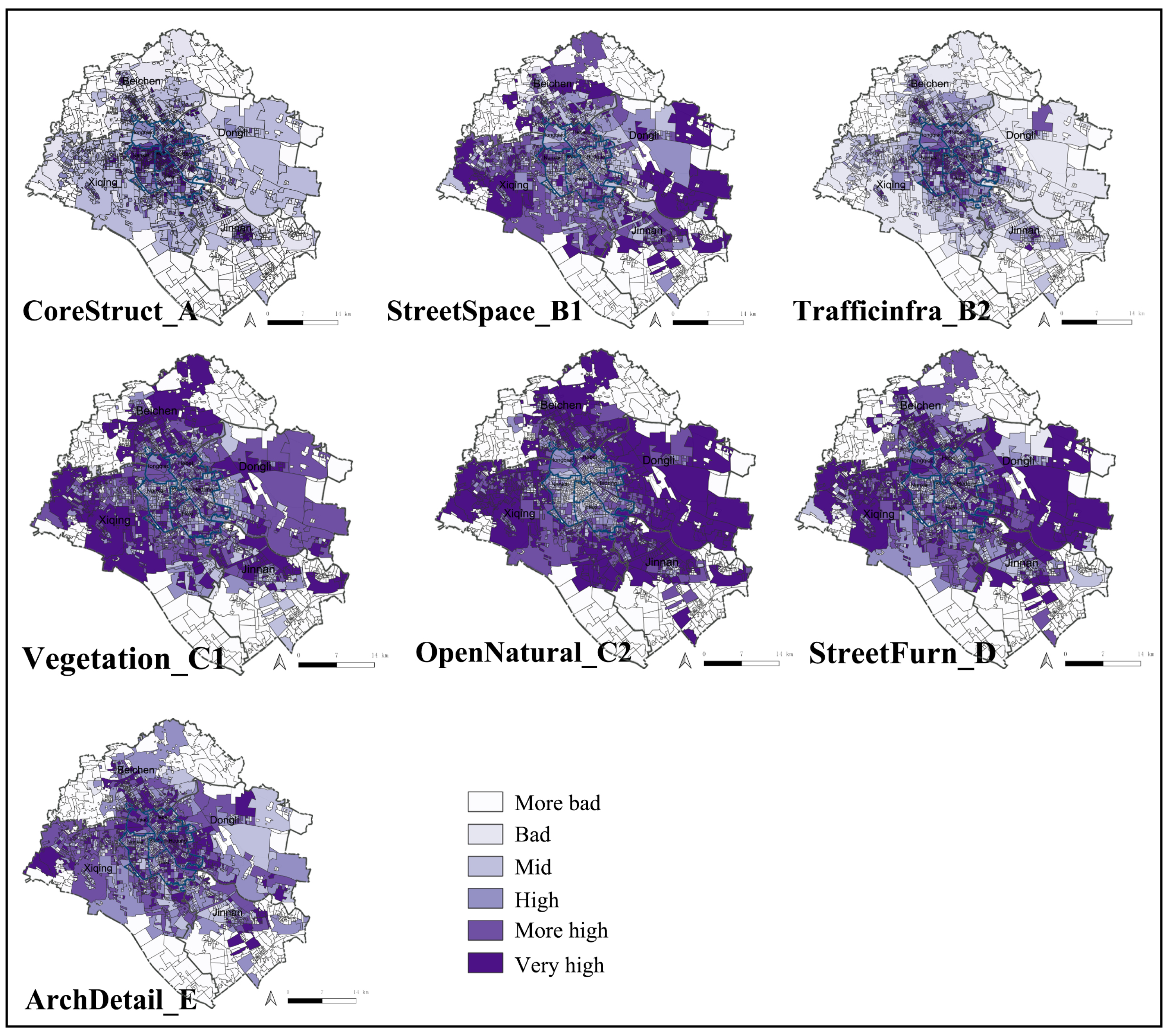

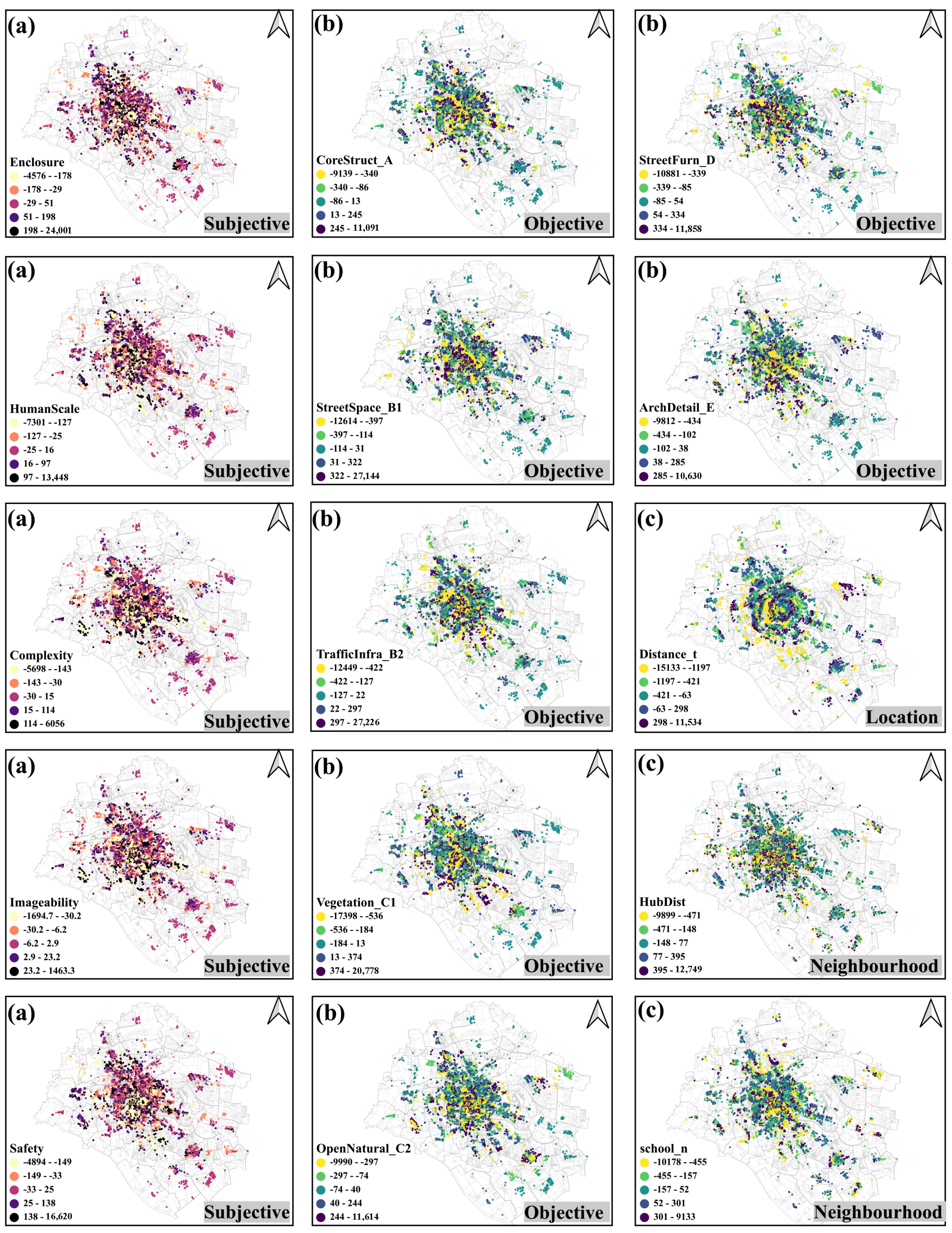


| Variable | Description | Mean | Std | Data Source |
|---|---|---|---|---|
| Dependent variable | ||||
| Prices | RMB (Chinese currency)/m2, original price | 26.586 | 20.435 | Anjuke.com |
| Structural attributes | ||||
| Property_T | Property type 1: Apartment house 0 for non-apartment house | 0.05 | 0.22 | Web scraping from Anjuke.com |
| House_Age | Age of the building | 22.6 | 11.2 | |
| Year_Built | Year of completion of the house | 2001 | 11.2 | |
| Floor_Area | Floor area ratio of the house | 1.74 | 0.73 | |
| Greening_R | Green floor area ratio of the house | 1.74 | 0.73 | |
| Building_T | Type of construction of the house, 1: multi-story 0 for non-multi-story | 0.34 | 0.48 | |
| Property_F | Property charges (RMB/m2/month) | 1.14 | 1.18 | |
| Locational attributes | ||||
| Distance_t | Distance to CBD (m) | 8694.1 | 6614.5 | Calculated in QGIS |
| Neighborhood attributes | ||||
| HubDist | Distance to the nearest bus and metro station (m) | 196.9 | 136.8 | Calculated in QGIS |
| recreation_n | Number of recreational and commercial amenities within 1000 m | 25.4 | 19.45 | |
| school_n | Number of schools in 1000 m | 24 | 24.5 | POI Data |
| hospital_n | Number of hospitals in 1000 m | 20.4 | 14.4 | |
| Subjective perceptions | ||||
| Enclosure | Enclosure perception | 0.67 | 0.06 | Predicted by ML models with view indices extracted fromSVIs |
| HumanScale | HumanScale perception | 0.66 | 0.10 | |
| Complexity | Complexity perception | 0.70 | 0.05 | |
| Imageability | Imageability perception | 0.65 | 0.05 | |
| Safety | Safety perception | 0.62 | 0.06 | |
| Objective view index | ||||
| CoreStruct_A | Building + Skyscraper view index | 0.46 | 0.15 | Scores derived from combining selected physical feature view indices |
| StreetSpace_B1 | Road + Sidewalk + Bridge view index | 0.28 | 0.08 | |
| TrafficInfra_B2 | Car + Bicycle + Minibike + Person view index | 0.08 | 0.03 | |
| Vegetation_C1 | Tree + Plant + Grass view index | 0.05 | 0.03 | |
| OpenNatural_C2 | Sky + Earth view index | 0.23 | 0.09 | |
| StreetFurn_D | Fence + Streetlight + Signboard + Awning + Ashcan view index | 0.02 | 0.01 | |
| ArchDetail_E | Wall view index | 0.007 | 0.008 | |
| (a) Descriptive Summary | (b) Gini Importance | |||||||
|---|---|---|---|---|---|---|---|---|
| Sort | View Index | Mean | Std. | Enclosure | Human Scale | Complexity | Imageability | Safety |
| 1 | Building | 15.7% | 13.6% | 0.28 | 0.27 | 0.22 | 0.24 | 0.26 |
| 2 | Sky | 31.1% | 10.9% | 0.23 | 0.24 | 0.1 | 0.12 | 0.21 |
| 3 | Earth | 1.9% | 5.7% | 0.08 | 0.07 | 0.1 | 0.09 | 0.02 |
| 4 | Car | 7.2% | 4.7% | 0.07 | 0.09 | 0.1 | 0.11 | 0.08 |
| 5 | Sidewalk | 2.4% | 5.0% | 0.05 | 0.06 | 0.05 | 0.04 | 0.05 |
| 6 | Person | 0.7% | 0.3% | 0.02 | 0.06 | 0.3 | 0.4 | 0.01 |
| 7 | Minibike | 0.0% | 0.2% | 0.02 | 0.03 | 0.02 | 0.01 | 0.00 |
| 8 | Fence | 3.0% | 4.2% | 0.03 | 0.04 | 0.02 | 0.02 | 0.03 |
| 9 | Road | 28.3% | 9.2% | 0.02 | 0.02 | 0.04 | 0.07 | 0.10 |
| 10 | Skyscraper | 28.3% | 9.2% | 0.05 | 0.03 | 0.02 | 0.02 | 0.03 |
| 11 | Tree | 5.8% | 6.2% | 0.02 | 0.04 | 0.07 | 0.02 | 0.09 |
| 12 | Ashcan | 0.0% | 0.1% | 0.02 | 0.01 | 0.01 | 0.00 | 0.01 |
| 13 | Bicycle | 0.0% | 0.2% | 0.01 | 0.01 | 0.02 | 0.03 | 0.01 |
| 14 | Streetlight | 0.0% | 0.01% | 0.02 | 0.01 | 0.02 | 0.00 | 0.01 |
| 15 | Signoboard | 0.2% | 0.6% | 0.01 | 0.01 | 0.00 | 0.01 | 0.01 |
| 16 | Grass | 0.4% | 1.5% | 0.04 | 0.01 | 0.02 | 0.01 | 0.02 |
| 17 | Wall | 0.8% | 3.2% | 0.01 | 0.00 | 0.01 | 0.01 | 0.02 |
| 18 | Bridge | 0.7% | 3% | 0.00 | 0.00 | 0.00 | 0.01 | 0.01 |
| 19 | Plant | 0.7% | 2.0% | 0.00 | 0.00 | 0.00 | 0.00 | 0.01 |
| 20 | Awning | 0.0% | 0.1% | 0.00 | 0.01 | 0.00 | 0.01 | 0.01 |
| 21 | Van | 0.0% | 0.3% | 0.00 | 0.01 | 0.00 | 0.01 | 0.00 |
| 22 | Railing | 0.0% | 0.4% | 0.00 | 0.00 | 0.00 | 0.00 | 0.00 |
| 23 | Mountain | 0.0% | 0.1% | 0.00 | 0.00 | 0.00 | 0.00 | 0.00 |
| 24 | Fountain | 0.0% | 0.0% | 0.00 | 0.00 | 0.00 | 0.00 | 0.00 |
| 25 | Column | 0.0% | 0.1% | 0.00 | 0.00 | 0.00 | 0.00 | 0.00 |
| 26 | Ceiling | 0.1% | 2.2% | 0.00 | 0.00 | 0.00 | 0.00 | 0.00 |
| 27 | Windowpane | 0.0% | 0.0% | 0.00 | 0.00 | 0.00 | 0.00 | 0.00 |
| 28 | Chair | 0.0% | 0.0% | 0.00 | 0.00 | 0.00 | 0.00 | 0.00 |
| 29 | Sculpture | 0.0% | 0.0% | 0.00 | 0.00 | 0.00 | 0.00 | 0.00 |
| 30 | Booth | 0.0% | 0.0% | 0.00 | 0.00 | 0.00 | 0.00 | 0.00 |
| Perception | R2 | MAE | RMSE | Std. Dev. | Estimators (Bootstrap) | Min Split (Leaf) | Max Feature (Depth) | Roy [64] (2016) |
|---|---|---|---|---|---|---|---|---|
| Enclosure | 0.79 | 0.0789 | 0.0953 | 0.1694 | 300 (False) | 2 (1) | sqrt (20) | Moderate |
| Human Scale | 0.63 | 0.0990 | 0.1109 | 0.1555 | 100 (True) | 5 (2) | sqrt (10) | Bad |
| Complexity | 0.67 | 0.0955 | 0.1183 | 0.1700 | 100 (False) | 10 (1) | sqrt (10) | Moderate |
| Imageability | 0.53 | 0.0911 | 0.1144 | 0.1765 | 200 (False) | 2 (1) | sqrt (30) | Bad |
| Safety | 0.70 | 0.0833 | 0.1218 | 0.1754 | 100 (True) | 2 (1) | sqrt (10) | Moderate |
| Model 0 | Model 1 | Model 2 | |
|---|---|---|---|
| Attributes Method | Baseline OLS | Subjective OLS | Objective OLS |
| Adjusted (Pseudo ) | 0.539 | 0.550 | 0.577 |
| Moran’s I on Residual (p-value) | 0.01 *** | 0.01 *** | 0.01 *** |
| Robust LM (lag) | 601.947 *** | 576.633 *** | 648.214 *** |
| Robust LM (error) | 2174.761 *** | 2119.758 *** | 1944.270 *** |
| Model 0 | Model 1 | Model 2 | Model 3 | |
|---|---|---|---|---|
| Attributes Method | Suburban Ring Districts Global Model | Central Urban Districts Global Model | Urban Core (10 Districts) Global Model | Urban Core (10 Districts) Local Model |
| Test | 0.598 | 0.710 | 0.763 | 0.781 |
| MAE (RMB) | 918.838 | 3494.125 | 6191.972 | – |
| RMSE (RMB) | 2277.117 | 6957.690 | 10,139.574 | – |
Disclaimer/Publisher’s Note: The statements, opinions and data contained in all publications are solely those of the individual author(s) and contributor(s) and not of MDPI and/or the editor(s). MDPI and/or the editor(s) disclaim responsibility for any injury to people or property resulting from any ideas, methods, instructions or products referred to in the content. |
© 2025 by the authors. Published by MDPI on behalf of the International Society for Photogrammetry and Remote Sensing. Licensee MDPI, Basel, Switzerland. This article is an open access article distributed under the terms and conditions of the Creative Commons Attribution (CC BY) license (https://creativecommons.org/licenses/by/4.0/).
Share and Cite
Zhou, S.; Ji, Q.; Zhang, L.; Wu, J.; Li, P.; Zhang, Y. Exploration of Differences in Housing Price Determinants Based on Street View Imagery and the Geographical-XGBoost Model: Improving Quality of Life for Residents and Through-Travelers. ISPRS Int. J. Geo-Inf. 2025, 14, 391. https://doi.org/10.3390/ijgi14100391
Zhou S, Ji Q, Zhang L, Wu J, Li P, Zhang Y. Exploration of Differences in Housing Price Determinants Based on Street View Imagery and the Geographical-XGBoost Model: Improving Quality of Life for Residents and Through-Travelers. ISPRS International Journal of Geo-Information. 2025; 14(10):391. https://doi.org/10.3390/ijgi14100391
Chicago/Turabian StyleZhou, Shengbei, Qian Ji, Longhao Zhang, Jun Wu, Pengbo Li, and Yuqiao Zhang. 2025. "Exploration of Differences in Housing Price Determinants Based on Street View Imagery and the Geographical-XGBoost Model: Improving Quality of Life for Residents and Through-Travelers" ISPRS International Journal of Geo-Information 14, no. 10: 391. https://doi.org/10.3390/ijgi14100391
APA StyleZhou, S., Ji, Q., Zhang, L., Wu, J., Li, P., & Zhang, Y. (2025). Exploration of Differences in Housing Price Determinants Based on Street View Imagery and the Geographical-XGBoost Model: Improving Quality of Life for Residents and Through-Travelers. ISPRS International Journal of Geo-Information, 14(10), 391. https://doi.org/10.3390/ijgi14100391






